-

人教版新目标初中英语七年级下册What do you think of game shows教案
五、教学Section B-2c1. Pair work: What do you think of the belt/sunglasses/…? What does your father/mother/… think of your scarf/belt…?2. Group work(1). Teacher shows some different kinds of school uniforms (制服)and asks : “ What do you think of your school uniforms? If you have a chance to choose your school uniforms, what kind would you like to choose?”(2). Discuss in groups.(3).Get some Ss to report in class.说明:这一步旨在让学生运用已有的语言知识谈论对事物的看法和意见,并简单阐明理由,培养学生的主动思维能力和运用英语的能力。六、教学拓展调查电视节目的收视率任务:调查你周围的人对现在各种电视节目的反响。活动过程:1.教师布置任务,让学生调查周围的人(包括他的亲戚朋友和邻居)喜欢收看哪方面的电视节目。2.学生进行调查活动,运用本单元所学的句型What do you think of….? (Why?)What's your favorite game shows?What do you think of talk show?I doesn’t mind it.I like it.I love it.I can’t stand it.3.记录下排在前10位的TV Program,填写调查表,比较其收视率。

人教版新目标初中英语七年级下册Where did you go on vacation教案
句型: Where did you go on vacation? I went to summer camp.Did she go to Central Park?Yes,she did.No, she didn’t语法:一般过去时特殊疑问句、一般疑问句及肯、否定回答。课时安排4课时第一课时:Section A:la,1b,lc,2a,2b,2c 第二课时:Section A:3a,3b,4第三课时:Section B:1,2a,2b,2c第四课时:Section B:3a,3b,3c,4 and Self Check第一课时教学目标掌握描写假期生活的形容词。假期里自己所做事情的简单表达。谈论假期做的事情及当时情况。谈论假期时旅游的天气,旅游者以及食物等。教学过程一、导入播放一首英文歌曲:Let’s travel 说明:通过让学生听节奏欢快迪斯尼英语歌曲Let’s travel.引入本节课谈论的话题vacation and travel. 让歌曲使学生的思维活跃,增强课堂气氛,激发学生提高学习英语的兴趣。T:How is the trip ?Ss : It’s pretty good/ happy/exciting /relaxing/busy/dangerous/ fantastic说明:这个问题是为了操练形容词。建议让多个Ss作答。鼓励他们用不同的形容词。上述个别形容词本应在第二课时中出现,但可以在warming-up中第一次非正式出现。这些形容词也可在老师的评价语中适时出现,以加深学生对词汇的印象。

人教版新目标初中英语九年级上册Teenagers should be allowed to choose their own clothes教案2篇
Step 1 Greeting Greet the class and check the homeworkStep 2 A duty report The S on duty gives a report on the rules in his home and lead in 3a “Sun Fei’s and Wu Yu’s rules” Step 3 ReadingSs read the conversation and write the two girls’ rules in the chart. Check the answers.Get Ss to read after the tape and then read aloud by themselves. Then, T explains the language points.Step 4 Pairwork 3bRole play. Use the information in chart to practice with the conversation in 3a covered. They can look at the sample conversation in the right box.Step 5 Task 2 “Who’s the best reporter?”Make a survey by asking any 5 students the questions in the chart in activity 4. Then give out a report about it. See who is the best reporter? And the best reporter will get a nice ball-pen.Step 6 Summary and homework:Write out the report in your exercise-books.Period ThreeStep 1 Greeting and a duty reportThe S gives a duty report talking about his experience of being late for school. Lead in the question “Do you ever get to school late? How often do you get to school late? Always, usually, sometimes, or never?Step 2 1a Get Ss to finish writing.Step 3 Pairwork 1b Get Ss to talk about their answers with their partners using the sample conversation in the box on the right.Step 4 Listening practice2a Lead-in: What will happen if you get to school late? What about Peter? Let’s listen to a conversation between Peter and his father. Get Ss to finish 2a (As usual, for the first time, Ss only listen.) Check the answers.

人教版新目标初中英语九年级上册How do you study for a test教案2篇
内容提示本单元主要内容是学会利用verb十by/with gerund表示方式方法来讨论学习英语的策略,认识自己在学习方面的长处和不足。初步了解现在完成时的结构和用法。现在完成时由助动词have/has+动词的过去分词构成,主要表示过去发生的某一动作对现在仍有影响或造成的后果,常与already,yet,just,ever,never等副词连用。教学目标一、学习目标(Language Goal) 1. Talk about how to study . 学会讨论各种学习方法和策略。2. Find out your suitable learning methods. 找出适合自己的学习方法。 二、语言结构(Language Structures) 1. Verb + by with gerund by+动名词短语 表示“通过…途径,方法” 2. How questions have引导的特殊疑问句 三、目标语言(Target Language) 1. How do you study for tests ? 你是怎样准备考试的?Well , I study by working with my classmates. 哦,我和同学们一起学习。2. Have you ever studied with a group ? 你曾经参加过学习小组吗?Yes , I have . I’ve learned a lot that way . 是的,参加过。通过这种方式我学了许多。

人教版新目标初中英语九年级下册By the time I got outside, the bus had already left教案
Ⅰ. Teaching Aims and Demands1. Knowledge Objects(1) Key Vocabularyoversleep(2) Target LanguageWhat happened?I overslept. And by the time I got up, my brother had already gotten in the shower.2. Ability Objects(1) Teach the students to use the new words.(2) Train the students to narrate past events with the Past Perfect Tense.(3) Train the students' listening and speaking skills with the target language.3. Moral ObjectIt’s a good habit to go to bed early in the evening and get up early in the morning. So you’ll never be in a hurry in the morning.Ⅱ. Teaching Key Points1. Key Vocabularyoversleep2. Target LanguageNarrate past events with the Past Perfect TenseⅢ. Teaching Difficult Points1. Train the students to narrate past events with the Past Perfect Tense.2. Train the students to understand the target language in spoken conversation.Ⅳ. Teaching Methods1. Thinking of examples from the students' real lives.2. Making sentences by looking at the pictures.Ⅴ. Teaching AidA tape recorderⅥ. Teaching ProceduresStep I Revision1. Revise the language points in Unit 8.Ask some questions like this: What volunteer work would you like to do?Help the students to answer, I’d like to…/I love to…/I hope to2. Practice the dialogue in Activity 3c on page 62 again. Get students to role play the similar dialogues with the following.

人教版新目标初中英语九年级上册Where would you like to visit教案2篇
The First PeriodⅠ.Teaching Aims and DemandsKnowledge Objects(1) Key Vocabularytiring, educational, fascinating, thrilling, peaceful, exotic, trek, jungle, take it easy, explore, historic, site(2) Target LanguageWhere would you like to go on vacation?I’d like to trek through the jungle, because I like exciting vacations.2. Ability Objects(1)Train students to talk about places they would like to visit with the target language.(2)Train students to describe vacations with different adjectives.(3)Train students' listening skill.3. Moral Object,It′s more interesting to go on vacating somewhere instead of staying at home.Ⅱ. Teaching Key Points1. Key Vocabularytiring, educational, fascinating, thrilling, peaceful, exotic, trek, jungle, take it easy, explore, historic, site2. Target LanguageTalk about different places with the target language.Ⅲ. Teaching Difficult Points1. Describe vacations with different adjectives.2. Talk about different places with the target language.Ⅳ. Teaching Methods1. Teaching by illumination2. Teaching by doing chain drills3. Teaching by pairworkⅤ. Teaching Aids1. A tape recorder2. Some pictures of different places with famous views

人教版新目标初中英语九年级下册Could you please tell me where the restrooms are教案
Step Ⅰ RevisionCheck homework. Ask a few students to read the article in 3a.Then ask a few students to read their guides.Step Ⅱ Part 1Look at the words in the box. Ask a student to read them. Make sure the students understand the meaning of the words. You are to fill in the blanks with the words. In some cases, students may need to use another form of the word, for example adjusting for tense or subject/ verb agreement.Ask students to fill in the blanks on their own.Check the answers. Step ⅢPart 2Go through the instructions with the class.Look at the example with the students.Ask students what the answer would be.Ask a student to read the question and answer it.Excuse me, could you tell me where the bank is, please?The bank is across the street from the shopping malt.Get students to complete the work in pairs.Check the answers. Ask a few students to read their questions.Step Ⅳ Just for Fun!Ask all the students to read the conversation. Ask: What is funny about this cartoon? Help students to explain. A Martian is a person from the planet Mars.There is no such thing as Martian food on Earth, and the clerk looks silly because he is trying to think of where there is a Martian restaurant.Invite some pairs of students to present this conversation to the rest of the class.Step Ⅴ Summary and HomeworkIn this class, we’ve done much writing practice using the key vocabulary words and the target language presented in this unit. After class, please finish the questions in 2 in your exercise books. Then finish the exercises on pages 47~48 of the workbook as well.The Seventh Period Ⅰ Teaching Aims and Demands1. Knowledge Objects(1) Key Vocabularyimage, adventure, jealousy, hero, crime, journey, brave, no longer, show interest in, take it easy, become interested in, plain looks(2)Text:Grown-ups like cartoons, too.2. Ability Objects(1) Fast-reading to get a general idea of the text.(2) Careful-reading to get the detailed information in the text.

人教版新课标小学数学二年级上册表内乘法(一)教案
(6)交流。6的乘法口诀一共有几句?口诀中的第一个数与算式中的第二个因数相同,表示什么?口诀中的第二个数与算式的第一个因数相同,表示什么?相邻两句口诀的积相差几?哪几句难记一些?你用什么方法记呢?怎样记住"三六十八"、"四六二十四"两句口诀?教师在学生发言的基础上鼓励学生大胆说、想出不同记口诀的方法。(7)应用"做一做"第1题(学生半独立完成):①用6根小棒摆1个六边形;②摆2个六边形要用多少根小棒?你是怎样想的?(想口诀"二六十二"。)③运用所学的口诀口答摆4个、6个、3个、5个六边形所需要向小棒数。"做一做"第2题(独立完成):①将第2题改为填空题,在圆圈内填写正确的积;②口答得数,并说一说所用口诀。
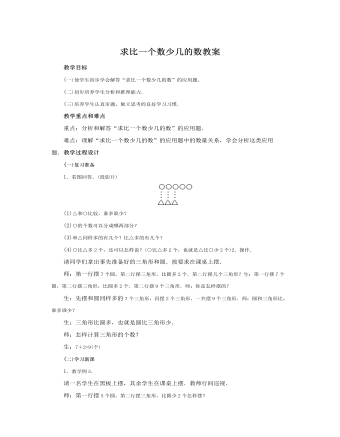
人教版新课标小学数学二年级上册求比一个数少几的数教案
课堂教学设计说明求比一个数少几的数的应用题是低年级教学的一个难点.为了分散难点,在复习准备阶段做了孕伏.如:圆比三角形多2个,也可以说三角形比圆少2个.为了突破难点,让学生动手摆、动口说、动笔写,全方位地调动学生的各种感官参与教学全过程,使学生在参与学习的活动中领悟出“求比一个数少几的数”的应用题仍然是把较大数看作两部分组成的,从大数中去掉大数比小数多的部分,就是小数与大数同样多的部分,也就是小数的数值.也可以通过“假设同样多”去透彻地理解比一个数少几的实际意义.确实使学生理解和掌握了这类应用题用减法计算的道理和解答方法.为了让学生进一步加深理解和掌握“求比一个数少几的数”的应用题的数量关系和解答方法,在巩固练习的最后设计了一组对比题目.
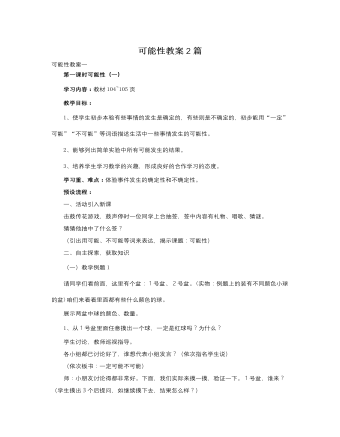
人教版新课标小学数学三年级上册可能性教案2篇
D、师:通过刚才摸球,你认为我们能摸到黄球吗?(能)一定能摸到黄球吗?(不一定)也就是说我们摸到的可能是黄球,也可能是白球。(板书:可能)3、超级竞猜:出示挂图,学生抢答。(课本105页例1)三、拓展应用1、师:在我们生活中同样有很多事情都可以用这些表示可能性的词语来表述。2、完成例2。(1)出示挂图,小组讨论。(2)组织学生汇报交流、评价,你想说哪一幅图的内容就说哪一幅。3、你还能用这些词来说说生活里的事吗?先和同桌交流,然后组织汇报、评价。4、游戏:在三叠卡片中各选一张,按排列顺序组成一句话,说一说这件事发生的可能性。5、作业:在书上完成108页第1、2题。四、总结全课1、师:今天,我们主要学习了什么内容?2、小结:生活里可能性的事情还有很多很多,有些事情一定会发生,有些事情可能会发生,有些事情不可能会发生。希望同学们做生活中的有心人,找一找生活中的可能性。
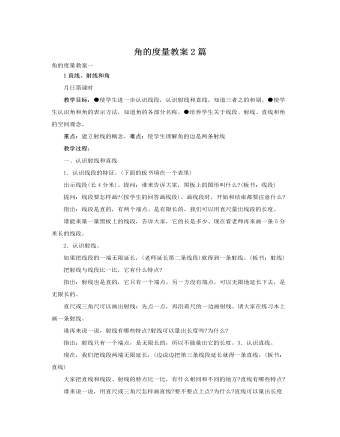
人教版新课标小学数学四年级上册角的度量教案2篇
一、认识射线和直线1.认识线段的特征。(下面的板书填在一个表里)出示线段(长4分米)。提问:谁来告诉大家,黑板上的图形叫什么?(板书:线段)提问:线段要怎样画?(按学生的回答画线段)。画线段时,开始和结束都要注意什么?指出:线段是直的,有两个端点。是有限长的,我们可以用直尺量出线段的长度。谁能来量一量黑板上的线段,告诉大家,它的长是多少。现在看老师再来画一条5分米长的线段。2.认识射线。如果把线段的一端无限延长,(老师延长第二条线段)就得到一条射线。(板书:射线)把射线与线段比一比,它有什么特点?指出:射线也是直的,它只有一个端点。另一方没有端点,可以无限地延长下去,是无限长的。直尺或三角尺可以画出射线:先点一点,再沿着尺的一边画射线。请大家在练习本上画一条射线。
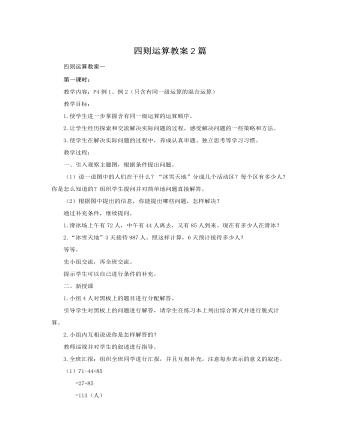
人教版新课标小学数学四年级下册四则运算教案2篇
(1)请学生用和、差、积、商说说运算顺序。(2)计算,写出计算过程。(3)交流,改错。2、学校食堂买来大米850千克,运了三车,还剩100千克,平均每车运多少千克。(1)请两位同学来读题,其他同学来说一说你读懂了什么?(2)分析数量关系,列式解答,说说算式每一步的意思,再说说运算顺序,看看算式意思是否跟运算顺序相符合。3、下面四张扑克牌上的点数,经过怎样的运算才能得到24呢?你能想出几种方法?(1)先进行小组合作,看看哪个小组列出的算式最多。(2)交流,列出各种方法。(6+4-2)×3 6×4÷(3-2) 64、旅行社推出“××风景区一日游”的两种出游价格方案。(1)分析两种方案的意思。(第一种方案是按人数买,成人和儿童的票价不一样;第二种方案按团体计价,五人以上就一口价每人100元。)(2)共同解决第(1)小题,分别让学生按两种方案分别购票,看看哪种方案购票便宜一些?(3)独立解答第(2)小题。(与第(1)小题是同样道理)
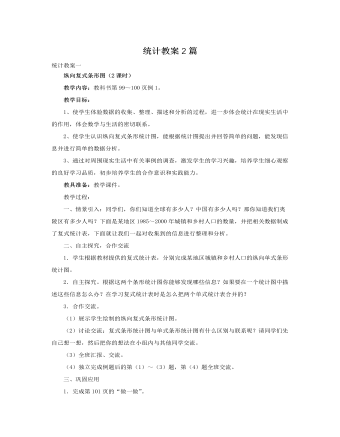
人教版新课标小学数学四年级上册统计教案2篇
教学目标:1、经历简单的收集、整理、描述和分析数据的过程。2、使学生初步了解数据的收集和整理过程,学会整理简单的数据,会看简单的统计表和统计图,会根据统计图表中的数据回答一些简单的问题。3、使学生体验解数据的收集、整理、描述和分析的过程,能发现信息并进行简单的数据分析。4、体会到数学知识与实际生活紧密联系,激发学生的学习兴趣,培养学生细心观察的良好学习品质。教学重点:绘制纵向复式条形统计图。教学难点:根据统计图发现问题、提出问题、解决问题。教具准备:课件。教学过程:一、情境导入:你们知道全球有多少人?中国有多少人吗?那你们知道自己所在的区有多少人吗?下面我们一起对收集到的信息进行整理和分析。二、探究新知:1、根据统计表,分别完成两个单式条形统计图2、根据两个条形统计图你能发现哪些信息?如果要在一个统计图中描述这些信息怎么办?在学习复式统计表时是怎么把两个单式统计表合并的?

人教版新课标小学数学五年级上册数字编码教案
2、互动交流,探究规律。 (1)、小组内交流讨论: 让每个同学说出自己的发现,说说自己的猜想,并讨论邮政编码中的数字是怎样编排的。(师巡视,随机参与讨论。) (2)、全班展示交流: 师:那个小组愿意先来展示一下你们的探究结果? 生1:我们发现邮政编码都是由6个数字组成的。…… 生2:我们发现前两位数字表示省,如…… 生3:同一个省、市的邮政编码前三位数字相同。比如……。 (让学生充分发言) 【设计意图:“自主探索——互动交流——汇报展示”,充分展现学生自主探究的过程,突出了学生的主体地位,培养了学生自主获取知识的能力和合作交流的意识。】 3、共同优化,形成结论。 (1) 教师配合多媒体课件说明邮政编码的结构和组成: 师:我国邮政编码的结构与含义采用“四级六位制”。编码含义:邮政编码的六位数字分别代表了省、市、邮政、县市、投递局四级单位。其中:前二位表示省(自治区、直辖市);前三位表示邮区;前四位表示县(市);最后两位表示投递局(所)
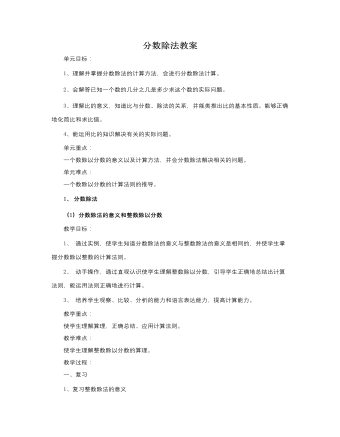
人教版新课标小学数学六年级上册分数除法教案
教学追记:本节课的内容相对而言较容易掌握,因而学生在学习中并没有出现什么困难。教学中,我两种方法并重,并让学生理解两种方法的殊途同归之处。对于类型稍有不同的题目,如“做一做”第2题,以人数为比例进行分配的,我在教学时添加了一道例题,教学后再让学生独力完成第2题,这样的教学让学生学得较为轻松,也对这种类型题掌握得较扎实。4、整理和复习整理复习(1)复习目标:使学生进一步掌握本章所学的基本概念和计算法则,提高学生的计算能力和解题能力。复习重点:分数除法的计算方法,化简比。复习难点:正确计算分数除法。复习过程:一、复习分数除法的意义和计算法则1、这一章我们学习了分数除法的有关知识.请大家回忆一下分数除法有几种类型?(1)分数除以整数,例如 ÷5;(2)一个数除以分数,它又包括整数除以分数,例如20÷ ;和分数除以分数,例如÷ 。(3)做第52页“整理和复习”的第2题。2、分数除法的意义
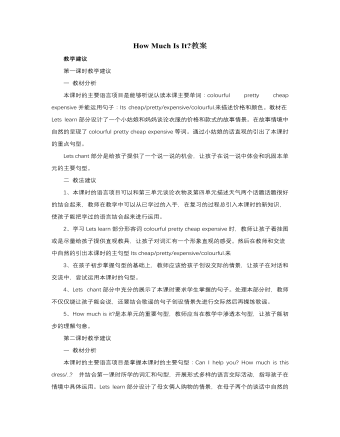
人教版新课标PEP小学英语四年级下册How Much Is It教案
一 教材分析本课时的主要语言项目是能够听说认读本课主要单词:colourful pretty cheap expensive并能运用句子:Its cheap/pretty/expensive/colourful.来描述价格和颜色。教材在Lets learn部分设计了一个小姑娘和妈妈谈论衣服的价格和款式的故事情景。在故事情境中自然的呈现了colourful pretty cheap expensive等词。通过小姑娘的话直观的引出了本课时的重点句型。Lets chant部分是给孩子提供了一个说一说的机会,让孩子在说一说中体会和巩固本单元的主要句型。二 教法建议1、本课时的语言项目可以和第三单元谈论衣物及第四单元描述天气两个话题话题很好的结合起来,教师在教学中可以从已学过的入手,在复习的过程总引入本课时的新知识,使孩子能把学过的语言结合起来进行运用。 2、学习Lets learn部分形容词colourful pretty cheap expensive时,教师让孩子看挂图或是尽量给孩子提供直观教具,让孩子对词汇有一个形象直观的感受。然后在教师和交流中自然的引出本课时的主句型Its cheap/pretty/expensive/colourful.来
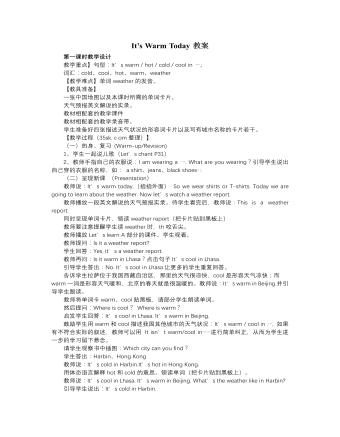
人教版新课标PEP小学英语四年级下册It’s Warm Today教案
1、Read and Write部分的课件及录音。 2、Pronunciation部部分的录音。 3、单词卡片:sunny,warm,cold,snowy,cool,cold, cloudy, hot, rainy, windy。 【教学过程 】 (一)热身、复习 (Warm-up/Revision) 出示单词卡:warm,hot,cool,cold,rainy,snowy,windy,sunny,cloudy,学生集体朗读。 请学生打开书P52,看记录回答教师问题: 教师提问:What’s the weather like in Beijing? What’s the weather like in Shanghai? 请4位学生分别提问Harbin,Lhasa,Urumqi,Hongkong的天气,大家回答。 请学生朗读P51对话后的句子:It’s cool. 在本上认真书写句子It’s cool. 教师要巡视检查。 (二)呈现新课 (Presentation) A. Lead-in 请学生继续看记录,教师提问: Is it warm in Beijing? Is it snowy in Harbin? Is it cool in Shanghai? Is it windy in Lhasa? Is it cold in Urumqi? Is it hot in Hong Kong? 引导学生根据记录用Yes, it is. 或No, it isn’t. 回答。 请学生用Is it…?分别猜一猜London,Sydney,Singapore,Moscow的天气,教师前一天根据天气预报情况用Yes, it is. 或No, it isn’t. 回答学生的提问。 请学生朗读P51对话后的句子:Is it cold?并说出意思。 学生在本上规范书写句子Is it cold?教师提示学生注意标点是?。

人教版新课标PEP小学英语六年级上册I Have a Pen Pal教案
(1)教师说:“Zhang Peng’s mother is a teacher.What does she teach? Does she teach English?”教师出示Let’s talk部分的挂图,放录音,学生听录音阅读对话。教师出示主句型:Does he/she…?Yes,he/she does.No,he/she doesn’t.然后教师引导学生回答刚刚提出的问题,逐步掌握肯定和否定回答。再放一遍, 学生跟读. (2)教师说:“My mother is a teacher,too.Do you want to know more about her.Ask me some questions.”教师依次出示B Let’s learn部分的单词卡片,提示学生根据上面的短语和黑板上的重点句型提问,教师作答。 (3)教师指导学生进行替换练习。必要时,提示学生可以换一下对话里的人物,f 如:Does your uncle live in the city? Yes,he does.Does your grandma live in the country? No,she doesn’t. (4)“寻找家园”游戏 教师准备一些卡片,正面写有人名,反面写有地名,如:city,country,village,farm,forest,mountain,nature park等。请一名学生上台抽取一张卡片,问台一学生:“Guess.Where does…live?’’学生猜:“Does he/she live in/on…?”猜对的小组得一分。

人教版新课标PEP小学英语六年级下册Recycle2 A Farewell Party教案
3. 新课呈现(Presentation) Let’s make (1)教师说:Miss White is making a book about her students. So she can remember them well.Who are the students? 请学生独立或分小组朗读四段短文,解释学生不理解的句子,然后说:There are four pictures below. Would you like to help Miss/White glue the pictures? 教师知道学生完成图文搭配的练习。 (2)教师发给每名学生一张铅画纸,说:Now please draw a picture of your best classmate. Then describe him or her.学生画一副最要好的同学的肖像,并在傍边配上对该同学的英语介绍。 学生上讲台介绍自己最要好的同学,请其他学生猜是谁,看谁说的生动又贴切,教师给予评价时注意强调第三人称单数形式的使用。 Story time 教师向学生展示Story time部分的教学挂图,指着最后一副图中的Zoom 和 Zip说 Look at the picture. Zoom and Zip are sad. They are saying goodbye to each other. Now let’s see What happened. 学生同桌之间合作阅读或是,然后教师提出问题Where is Zip going? Is this good news for zoom ? What grade is Zip going to be in? 教师放录音,学生录音跟读故事,然后再分角色朗读.
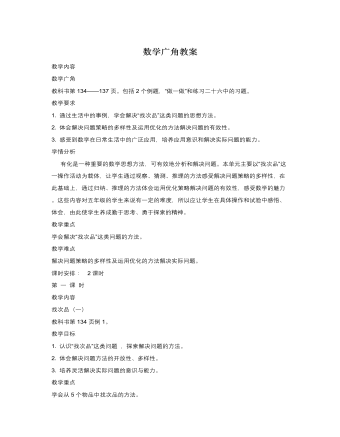
人教版新课标小学数学五年级下册数学广角教案
教学要求1. 通过生活中的事例,学会解决“找次品”这类问题的思想方法。2. 体会解决问题策略的多样性及运用优化的方法解决问题的有效性。3. 感受到数学在日常生活中的广泛应用,培养应用意识和解决实际问题的能力。学情分析有化是一种重要的数学思想方法,可有效地分析和解决问题。本单元主要以“找次品”这一操作活动为载体,让学生通过观察、猜测、推理的方法感受解决问题策略的多样性,在此基础上,通过归纳、推理的方法体会运用优化策略解决问题的有效性,感受数学的魅力。这些内容对五年级的学生来说有一定的难度,所以应让学生在具体操作和试验中感悟、体会,由此使学生养成勤于思考、勇于探索的精神。教学重点学会解决“找次品”这类问题的方法。

